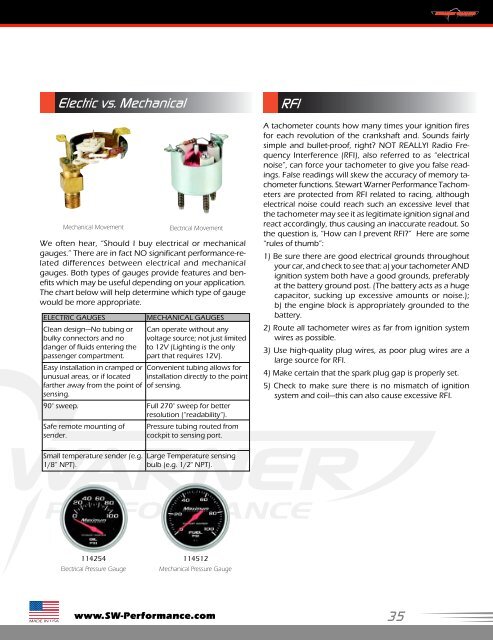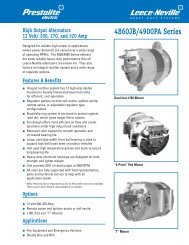Stewart Warner Performance Catalog - Auto Electric Service, Inc.
Stewart Warner Performance Catalog - Auto Electric Service, Inc.
Stewart Warner Performance Catalog - Auto Electric Service, Inc.
Create successful ePaper yourself
Turn your PDF publications into a flip-book with our unique Google optimized e-Paper software.
<strong>Electric</strong> vs. Mechanical RFI<br />
<strong>Electric</strong>al Movement<br />
We often hear, “Should I buy electrical or mechanical<br />
gauges.” There are in fact NO significant performance-related<br />
differences between electrical and mechanical<br />
gauges. Both types of gauges provide features and benefits<br />
which may be useful depending on your application.<br />
The chart below will help determine which type of gauge<br />
would be more appropriate.<br />
ELECTRIC GAUGES<br />
Clean design—No tubing or<br />
bulky connectors and no<br />
danger of fluids entering the<br />
passenger compartment.<br />
Easy installation in cramped or<br />
unusual areas, or if located<br />
farther away from the point of<br />
sensing.<br />
90° sweep.<br />
Mechanical Movement<br />
Safe remote mounting of<br />
sender.<br />
Small temperature sender (e.g.<br />
1/8” NPT).<br />
MECHANICAL GAUGES<br />
Can operate without any<br />
voltage source; not just limited<br />
to 12V (Lighting is the only<br />
part that requires 12V).<br />
Convenient tubing allows for<br />
installation directly to the point<br />
of sensing.<br />
Full 270° sweep for better<br />
resolution (“readability”).<br />
Pressure tubing routed from<br />
cockpit to sensing port.<br />
Large Temperature sensing<br />
bulb (e.g. 1/2" NPT).<br />
114254 114512<br />
<strong>Electric</strong>al Pressure Gauge<br />
Mechanical Pressure Gauge<br />
www.SW-<strong>Performance</strong>.com<br />
A tachometer counts how many times your ignition fires<br />
for each revolution of the crankshaft and. Sounds fairly<br />
simple and bullet-proof, right? NOT REALLY! Radio Frequency<br />
Interference (RFI), also referred to as “electrical<br />
noise”, can force your tachometer to give you false readings.<br />
False readings will skew the accuracy of memory tachometer<br />
functions. <strong>Stewart</strong> <strong>Warner</strong> <strong>Performance</strong> Tachometers<br />
are protected from RFI related to racing, although<br />
electrical noise could reach such an excessive level that<br />
the tachometer may see it as legitimate ignition signal and<br />
react accordingly, thus causing an inaccurate readout. So<br />
the question is, “How can I prevent RFI?” Here are some<br />
“rules of thumb”:<br />
1) Be sure there are good electrical grounds throughout<br />
your car, and check to see that: a) your tachometer AND<br />
ignition system both have a good grounds, preferably<br />
at the battery ground post. (The battery acts as a huge<br />
capacitor, sucking up excessive amounts or noise.);<br />
b) the engine block is appropriately grounded to the<br />
battery.<br />
2) Route all tachometer wires as far from ignition system<br />
wires as possible.<br />
3) Use high-quality plug wires, as poor plug wires are a<br />
large source for RFI.<br />
4) Make certain that the spark plug gap is properly set.<br />
5) Check to make sure there is no mismatch of ignition<br />
system and coil—this can also cause excessive RFI.<br />
35



